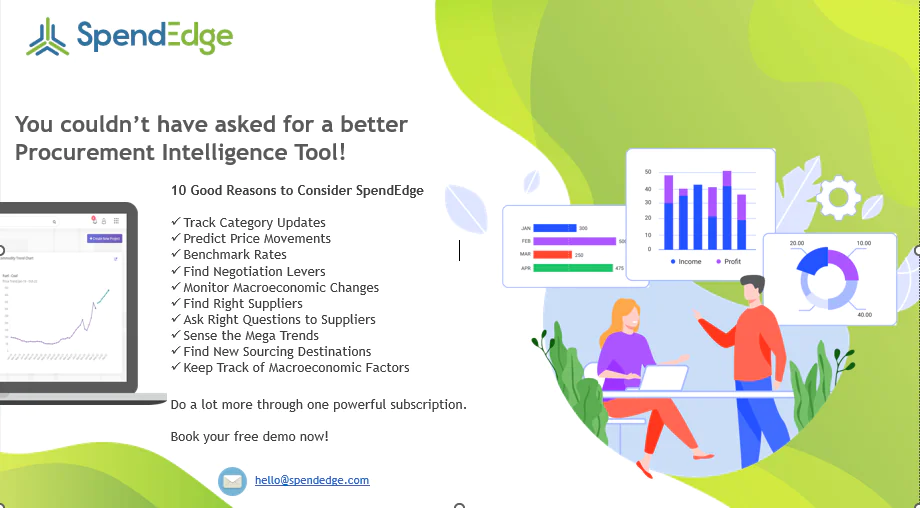As globalization continues to reshape the business landscape, the complexity of supplier risk management has amplified significantly. In this globalization era, companies must navigate diverse global strategies to adhere to stringent regulatory standards, identify and mitigate risks, and sustain peak productivity levels. However, the complexities of the global marketplace present several challenges, particularly concerning financial, compliance, and cybersecurity risks. Failure to effectively manage supplier risk can lead to severe consequences, including reputational damage, regulatory fines, and operational disruptions.
At SpendEdge, we understand the importance of supplier risk management for the smooth functioning of businesses. Therefore, in this blog, we are highlighting the step-by-step process that can lead to better supplier risk management.
How to Manage Supplier Risks?

Step 1: Certify
Selecting a supplier is not easy and comes with its own set of challenges. A strong supplier risk management process mitigates that risk by incorporating values into the current metrics and ensuring that suppliers associating with the company are able to meet their deadlines on time. It basically requires you to practice these functionalities in supplier risk management:
- Gaining expertise about the marketplace.
- Asking the precise questions in the RFP process during the bid.
- Verifying the information provided by suppliers against a third-party source.
- Centralizing information for established suppliers.
- Repeat the information to keep it updated.
Step 2: Monitor
Not every supplier holds equal value for your business. Strategically identify suppliers who are important for your supply chain and those who can cause disruption in the manufacturing line or services. Evaluating suppliers strategically and critically will help you determine the types of risk levers that can affect suppliers or the supply base. This supplier risk management process will require you to:
- Determine the sources of information that need to be monitored.
- Establish a supplier risk management framework that can monitor external and internal in real time.
Step 3: Analyze
Implement technologies to reduce the amount of time and effort required to analyze and create reports that can increase visibility and provide actionable intelligence. Areas to analyze can include financial risk, supplier performance, or spend category depending upon the profile of your company.
By repeating the supplier risk management process over regular intervals, you will gain a better understanding of how your supplier performs and what are the acceptable behavior thresholds. The points you should be addressing while analyzing are:
- The performance of your organization.
- The supplier’s performance against service level.
Step 4: Mitigate
Since predicting a supplier’s failure with complete accuracy can be a difficult task, you can always compensate for the same by planning for it. Proactively prepare for these potentially damaging supplier disruptions with supplier risk management in place. Also, developing a supplier risk assessment process, and building contingency plans by documenting competitive suppliers can help improvise plans according to the updated information.
Supplier Risk Management Strategy Outline
Supplier risk management (SRM) is crucial for organizations to identify, assess, and mitigate risks associated with third-party suppliers. The following outline provides a structured approach to developing an effective SRM program.
Key Strategies
- Cross-Departmental SRM Team
- Choose a Risk Management Framework
- Pre-Contract Due Diligence and Rfx Processes
- Focus on Visibility Over Supplier Profiles
- Categorize and Tier Suppliers Based on Inherent Risk
- Conduct a Periodic Risk Assessment
Cross-Departmental SRM Team
Establishing a cross-departmental team is essential for effective SRM governance. This team should include representatives from risk management, data protection, legal and compliance, security and IT, and procurement and sourcing. Engaging with product management and manufacturing is also vital to understand potential risks at each stage of the value chain. This collaborative approach ensures a comprehensive understanding of risks across various departments, facilitating more informed decision-making and risk mitigation strategies.
Choose a Risk Management Framework
Selecting an appropriate risk management framework serves as the foundation of your SRM program. Many organizations align their practices with established frameworks such as NIST or ISO, depending on their specific industry needs. These frameworks provide best practices and guidelines that help organizations systematically identify and manage supplier risks, enhancing overall resilience and compliance.
Pre-Contract Due Diligence and Rfx Processes
Conducting thorough pre-contract due diligence is critical in assessing potential vendors. This involves gathering information on business, financial, and reputational risks during the RFP (Request for Proposal), RFI (Request for Information), and other RFx processes. Sources for this information may include business news, adverse media coverage, financial records, sanctions list, and politically exposed persons (PEPs) lists. Utilizing risk profiling services can automate this process, ensuring a robust contract lifecycle management procedure is in place to safeguard against potential risks associated with new suppliers.
Focus on Visibility Over Supplier Profiles
Creating a centralized supplier database is key to effective SRM. This database should be comprehensive, including detailed supplier profiles, role-based access to contacts, demographics, and risk intelligence data. It should incorporate external risk information gathered during the sourcing phase as well as profiled risk data. Maintaining up-to-date records enhances visibility into supplier relationships and facilitates better risk assessment and management.
Categorize and Tier Suppliers Based on Inherent Risk
To optimize resource allocation within the SRM program, suppliers should be categorized and tiered according to their inherent risk levels. Inherent risk refers to the potential risk presented by a supplier before considering any controls implemented by the organization. Efficient categorization can be achieved through internal surveys combined with external risk information collected during procurement processes. This tiered approach allows organizations to prioritize their efforts on high-risk suppliers while managing resources effectively.
Conduct a Periodic Risk Assessment
Establishing a schedule for periodic risk assessments is crucial once suppliers have been identified and categorized. The frequency of these assessments can vary based on industry standards, regulatory requirements, or specific organizational needs. For instance, critical suppliers may require annual evaluations that assess their internal security controls, business continuity plans, and disaster recovery strategies. Regular assessments ensure that any emerging risks are identified promptly and addressed accordingly.
This structured approach to supplier risk management not only protects organizations from potential disruptions but also enhances overall supply chain resilience by fostering proactive risk identification and mitigation strategies.
Don’t leave your supply chain vulnerable. To learn how our innovative risk management frameworks can help you identify, assess, and mitigate supplier risks effectively, ensuring compliance and operational resilience in an ever-evolving marketplace…
Supplier Risk Landscape
| Risk Type | Key Points |
|---|---|
| Cybersecurity Risks | Organizations face escalating threats like data breaches, necessitating robust cybersecurity measures to protect sensitive data, especially Personally Identifiable Information (PII). |
| Compliance Risks | Adherence to regulatory standards such as ISO is crucial; non-compliance can lead to penalties and legal issues, highlighting the need for comprehensive compliance management. |
| Business & Financial Risks | Economic volatility and regulatory penalties threaten supply chain resilience; effective risk mitigation strategies are essential for maintaining financial stability. |
| Third-Party Risk Management | Increased reliance on third-party vendors expands the risk landscape; proactive assessment and management frameworks are vital for addressing vulnerabilities. |
| Event Risks | Unforeseen events like natural disasters can disrupt operations; vigilant monitoring and contingency planning are necessary to mitigate these risks. |
| ESG Risks | Environmental, Social, and Governance considerations are increasingly important; organizations must address ESG risks to uphold corporate responsibility and stakeholder trust. |
| Capacity Risks | Fluctuations in supplier capacity can disrupt continuity; proactive planning and diversification strategies are essential to manage these risks. |
| Performance Risks | Suppliers failing to meet agreements can compromise operations; rigorous performance monitoring and improvement initiatives are critical for mitigating these risks. |
| NIST Supply Chain Risk Management | Adhering to NIST controls helps establish robust practices for risk assessment, mitigation, and monitoring, enhancing overall supply chain resilience. |
Supplier Risk Management Best Practices
-
Comprehensive Third-Party Assessment
To effectively mitigate supply chain risks, it is essential to maintain accurate and up-to-date records of all third-party relationships, including dependencies on other vendors (Tier 2). Understanding these interconnections provides a clear view of potential risks across different supplier tiers, allowing for better decision-making and risk management strategies.
-
Risk Assessment and Vendor Evaluation
Regular risk assessments should be conducted on key suppliers, prioritizing those with the highest potential risks. Essential measures include on-site visits and procurement audits to verify compliance with ethical standards, health and safety regulations, corporate social responsibility, and financial stability, ensuring that suppliers meet the required criteria to reduce risk exposure.
-
Pre-Qualification of New Suppliers
Establish minimum compliance requirements for all new vendors to ensure alignment with industry laws and regulations. By incorporating these compliance standards into the vendor selection process, organizations can prevent non-compliant suppliers from entering the supply chain, ensuring legal and ethical standards are met from the beginning.
-
Special Attention to Sole-Source Suppliers
Sole-source suppliers should be given special attention due to their critical role in the supply chain. Regular site visits are necessary to assess potential risks, and contingency plans must be developed to address any disruptions. It is vital to ensure each sole-source contract includes a backup plan (Plan B) to avoid significant business interruptions in case of unforeseen issues.
-
Centralized Supplier Information Management
Centralizing all supplier information provides visibility into potential risks and helps avoid fragmented or missing records. A centralized repository of supplier data ensures that organizations can identify, track, and address risks more effectively, leading to stronger supplier relationships and improved risk management strategies across the supply chain.

Take the first step towards safeguarding your business from potential disruptions. For a comprehensive assessment of your supplier risk management strategies and discover tailored solutions that align with your organizational needs…





